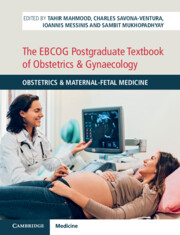Book contents
- The EBCOG Postgraduate Textbook of Obstetrics & Gynaecology
- The EBCOG Postgraduate Textbook of Obstetrics & Gynaecology
- Copyright page
- Dedication
- Contents
- Contributors
- Preface
- Section 1 Basic Sciences in Obstetrics
- Section 2 Early Pregnancy Problems
- Section 3 Fetal Medicine
- Section 4 Maternal Medicine
- Section 5 Intrapartum Care
- Section 6 Neonatal Problems
- Section 7 Placenta
- Section 8 Public Health Issues in Obstetrics
- Chapter 65 Social and Cultural Aspects Affecting Pregnancy Outcomes in Migrant Populations
- Chapter 66 Immunization in Pregnancy
- Chapter 67 Saving Lives, Improving Mothers’ Care
- Chapter 68 Clinical Governance in Obstetric Practice
- Chapter 69 Ethical Issues and Conflict in Maternal-Fetal Medicine and Obstetrics
- Chapter 70 Legal Considerations in Obstetric Practice
- Chapter 71 Research and Audit in Obstetric Practice
- Section 9 Co-Morbidities during Pregnancy
- Index
- Plate Section (PDF Only)
- References
Chapter 65 - Social and Cultural Aspects Affecting Pregnancy Outcomes in Migrant Populations
from Section 8 - Public Health Issues in Obstetrics
Published online by Cambridge University Press: 20 November 2021
- The EBCOG Postgraduate Textbook of Obstetrics & Gynaecology
- The EBCOG Postgraduate Textbook of Obstetrics & Gynaecology
- Copyright page
- Dedication
- Contents
- Contributors
- Preface
- Section 1 Basic Sciences in Obstetrics
- Section 2 Early Pregnancy Problems
- Section 3 Fetal Medicine
- Section 4 Maternal Medicine
- Section 5 Intrapartum Care
- Section 6 Neonatal Problems
- Section 7 Placenta
- Section 8 Public Health Issues in Obstetrics
- Chapter 65 Social and Cultural Aspects Affecting Pregnancy Outcomes in Migrant Populations
- Chapter 66 Immunization in Pregnancy
- Chapter 67 Saving Lives, Improving Mothers’ Care
- Chapter 68 Clinical Governance in Obstetric Practice
- Chapter 69 Ethical Issues and Conflict in Maternal-Fetal Medicine and Obstetrics
- Chapter 70 Legal Considerations in Obstetric Practice
- Chapter 71 Research and Audit in Obstetric Practice
- Section 9 Co-Morbidities during Pregnancy
- Index
- Plate Section (PDF Only)
- References
Summary
Over the last decades, the number of international migrants worldwide has not stopped growing. In 2017, there were 258 million international migrants worldwide, half of them women. Asia and Europe currently host 60% of all international migrants with 80 million and 78 million migrants each, followed by North America with 58 million [1]. With a growing number of migrants, healthcare workers in high-income countries will encounter them more frequently in their practice. Migrants, on the other hand, will encounter health professionals with sometimes very different cultural values and beliefs. These differences may cause misunderstandings and delays in accessing appropriate medical care during pregnancy and childbirth.
- Type
- Chapter
- Information
- The EBCOG Postgraduate Textbook of Obstetrics & GynaecologyObstetrics & Maternal-Fetal Medicine, pp. 525 - 531Publisher: Cambridge University PressPrint publication year: 2021

